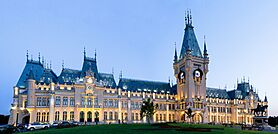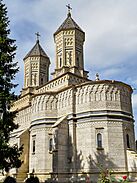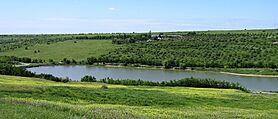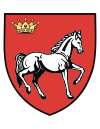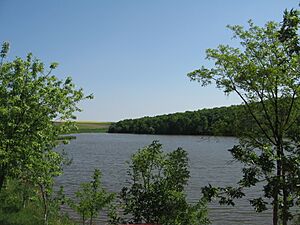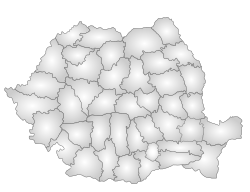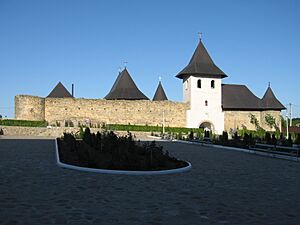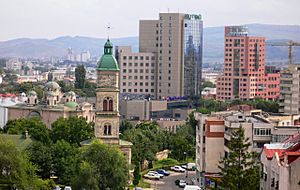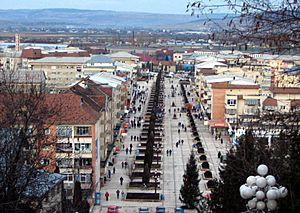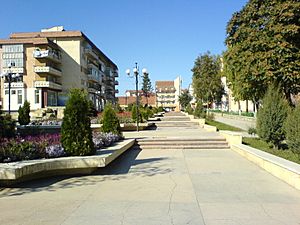Iași County facts for kids
Quick facts for kids
Iași County
Județul Iași
|
||
|---|---|---|
|
Palace of Culture
Trei Ierarhi Monastery
St. George Church, Hârlău
Starcea Lake, Butea
|
||
|
||
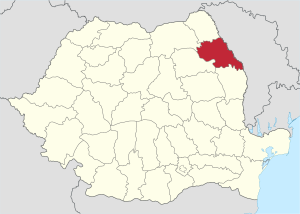 |
||
| Country | Romania | |
| Development region | Nord-Est | |
| Historical region | Western Moldavia | |
| Capital | Iași | |
| Government | ||
| • Type | County Board | |
| Area | ||
| • Total | 5,476 km2 (2,114 sq mi) | |
| Area rank | 23rd | |
| Population
(2021-12-01)
|
||
| • Total | 760,774 | |
| • Rank | 2nd | |
| • Density | 138.929/km2 (359.82/sq mi) | |
| Telephone code | (+40) 232 or (+40) 332 | |
| ISO 3166 code | RO-IS | |
| GDP (nominal) | US$ 5.431 billion (2015) | |
| GDP/per capita | US$ 27,032 (2022) | |
| Website | County Council Prefecture |
|
Iași County (pronounced "Yash") is a county in Romania. It is located in the eastern part of the country, in a historical region called Western Moldavia. The main city and administrative center of the county is Iași.
Iași County is one of the most populated counties in Romania. Only the city of Bucharest has more people.
Contents
Geography
Iași County covers an area of about 5,476 square kilometers. This is roughly the size of a large city. The county is mostly a flat area, like a big plain. It lies between two important rivers: the Siret River and the Prut River.
Two other rivers flow through the county. These are the Bahlui River and the Jijia River. The city of Iași is built on the banks of the Bahlui River.
Neighbours
Iași County shares borders with several other areas:
- To the east, it borders the Republic of Moldova. Specifically, it's next to the Ungheni District.
- To the west, it borders Neamț County.
- To the northwest, it borders Botoșani County and Suceava County.
- To the south, it borders Vaslui County.
Demographics
This section tells us about the people living in Iași County. At the 2021 census, Iași County had a population of 760,774 people. In 2011, there were 772,348 people. The population has changed over the years.
Most people in Iași County are Romanians. Here's a breakdown of the main groups:
The number of people living in Iași County has almost doubled in the last seventy years.
| Year | County population |
|---|---|
| 1948 | 431,586 |
| 1956 | 516,635 |
| 1966 | 619,027 |
| 1977 | 729,243 |
| 1992 | 806,778 |
| 2002 | 816,910 |
| 2011 | 772,348 |
| 2021 | 760,774 |
Economy
The economy of Iași County is mostly based on farming. This is because the land is flat and good for agriculture. However, there are also many industries, especially in the cities.
Some of the main industries in the county include:
- Software: Creating computer programs and apps.
- Pharmaceuticals: Making medicines.
- Automotive: Building cars and car parts.
- Metallurgy: Working with metals and making heavy machines.
- Electronics & Electrotechnics: Producing electronic devices.
- Textiles: Making clothes and fabrics.
- Food production: Processing food products.
Tourism
The city of Iași is a very important place in the region of Moldavia. It's known for its culture, history, and businesses. It has the oldest university in Romania. Iași was also once the capital of Moldavia before Romania became a united country.
Here are some interesting places to visit in Iași County:
- The city of Iași itself, with its famous Seven hills of Iași.
- The Alexandru Ioan Cuza Memorial Palace in Ruginoasa.
- The Cucuteni archeological site, where you can see ancient remains from the Stone Age.
- The famous vineyards of Cotnari and Bohotin.
- The Museum of Vineyard and Wine in Hârlău.
- Old monasteries like Hadâmbu and Dobrovăț.
- The beautiful Miclăușeni Castle and Monastery.
- The Memorial House of writer Vasile Alecsandri in Mircești.
- The Museum of writer Constantin Negruzzi in Hermeziu.
- The Museum of writer Cezar Petrescu in Cotnari.
- The cities of Pașcani, Târgu Frumos, and Hârlău.
- The Strunga health resort, a place for relaxation and healing.
Communities
Iași County has different types of communities:
- 2 large cities called municipalities.
- 3 smaller towns.
- 93 communes, which are groups of villages.
Municipalities
(Based on the 2021 census)
- Iași - population: 271,692 (and 465,477 in the wider urban area in 2014)
- Pașcani - population: 30,766
Towns
- Hârlău
- Podu Iloaiei
- Târgu Frumos
Communes
- Alexandru Ioan Cuza
- Andrieșeni
- Aroneanu
- Balș
- Bălțați
- Bârnova
- Belcești
- Bivolari
- Brăești
- Butea
- Ceplenița
- Ciohorăni
- Ciortești
- Ciurea
- Coarnele Caprei
- Comarna
- Costești
- Costuleni
- Cotnari
- Cozmești
- Cristești
- Cucuteni
- Dagâța
- Deleni
- Dobrovăț
- Dolhești
- Drăgușeni
- Dumești
- Erbiceni
- Fântânele
- Focuri
- Golăiești
- Gorban
- Grajduri
- Gropnița
- Grozești
- Hălăucești
- Hărmănești
- Heleșteni
- Holboca
- Horlești
- Ion Neculce
- Ipatele
- Lespezi
- Lețcani
- Lungani
- Mădârjac
- Mircești
- Mironeasa
- Miroslava
- Miroslovești
- Mogoșești
- Mogoșești-Siret
- Moșna
- Moțca
- Movileni
- Oțeleni
- Plugari
- Popești
- Popricani
- Prisăcani
- Probota
- Răchiteni
- Răducăneni
- Rediu
- Românești
- Roșcani
- Ruginoasa
- Scânteia
- Schitu Duca
- Scobinți
- Sinești
- Sirețel
- Stolniceni-Prăjescu
- Strunga
- Șcheia
- Șipote
- Tansa
- Tătăruși
- Țibana
- Țibănești
- Țigănași
- Todirești
- Tomești
- Trifești
- Țuțora
- Ungheni
- Valea Lupului
- Valea Seacă
- Vânători
- Victoria
- Vlădeni
- Voinești
Historical County
|
Județul Iași
|
||
|---|---|---|
|
County (Județ)
|
||
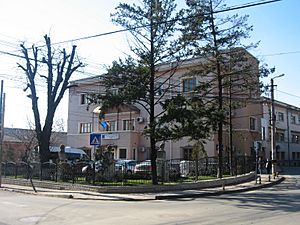
The building of the prefecture of Iași County from the interwar period, now the George Enescu National University of Arts
|
||
|
||
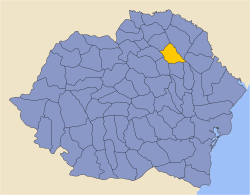 |
||
| Country | ||
| Historic region | Moldavia | |
| Capital city (Reședință de județ) | Iași | |
| Area | ||
| • Total | 3,227 km2 (1,246 sq mi) | |
| Population
(1930)
|
||
| • Total | 275,796 | |
| • Density | 85.465/km2 (221.35/sq mi) | |
| Time zone | UTC+2 (EET) | |
| • Summer (DST) | UTC+3 (EEST) | |
Long ago, there was also a historical Iași County. It was located in the northeastern part of what was then called Greater Romania. Most of that old county's land is now part of the current Iași County.
The old county also included a small part of the land on the left side of the Prut River. This area is now in the Republic of Moldova. The historical county bordered several other counties of that time.
In 1930, the historical county had a population of 275,796 people. Most of them were Romanians. The main cities in the historical county were Iași and Târgu Frumos.
See also
 In Spanish: Distrito de Iași para niños
In Spanish: Distrito de Iași para niños


